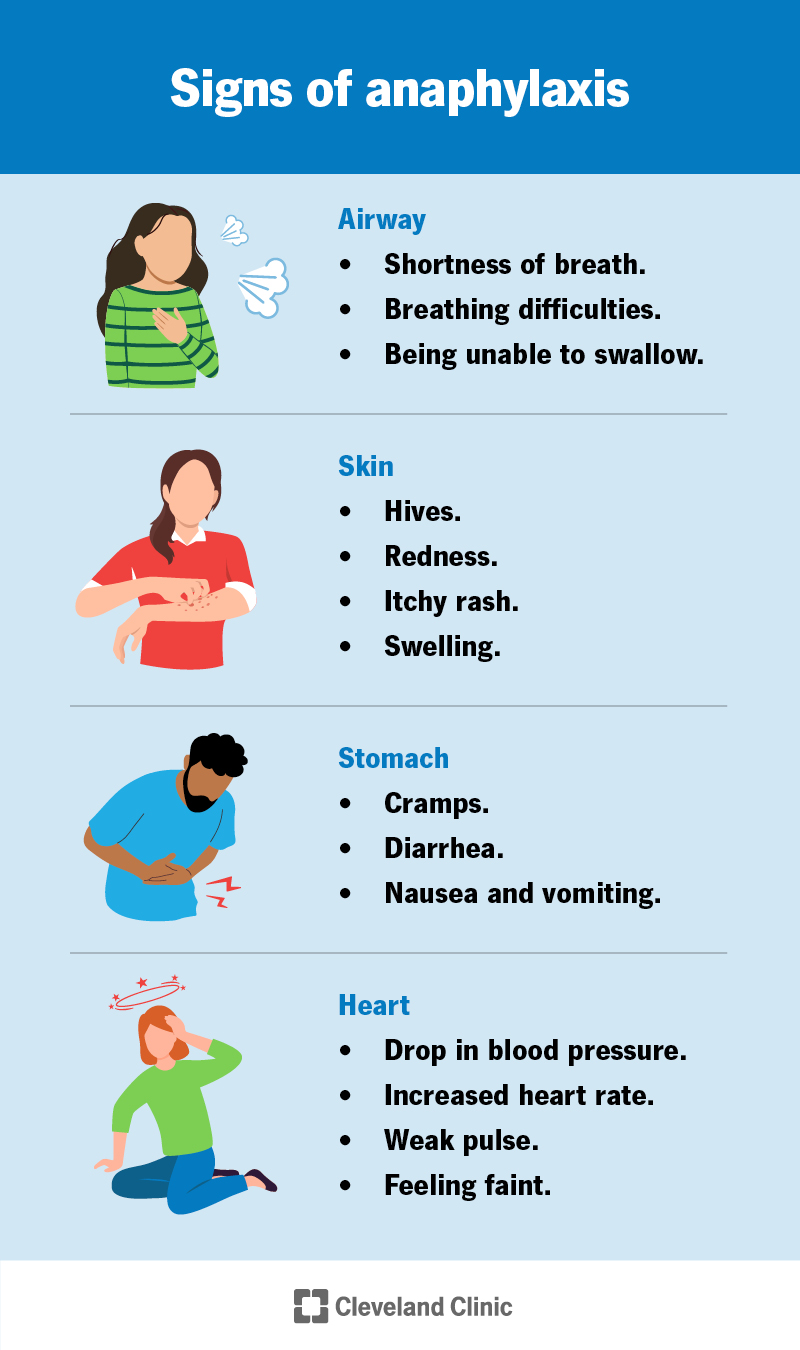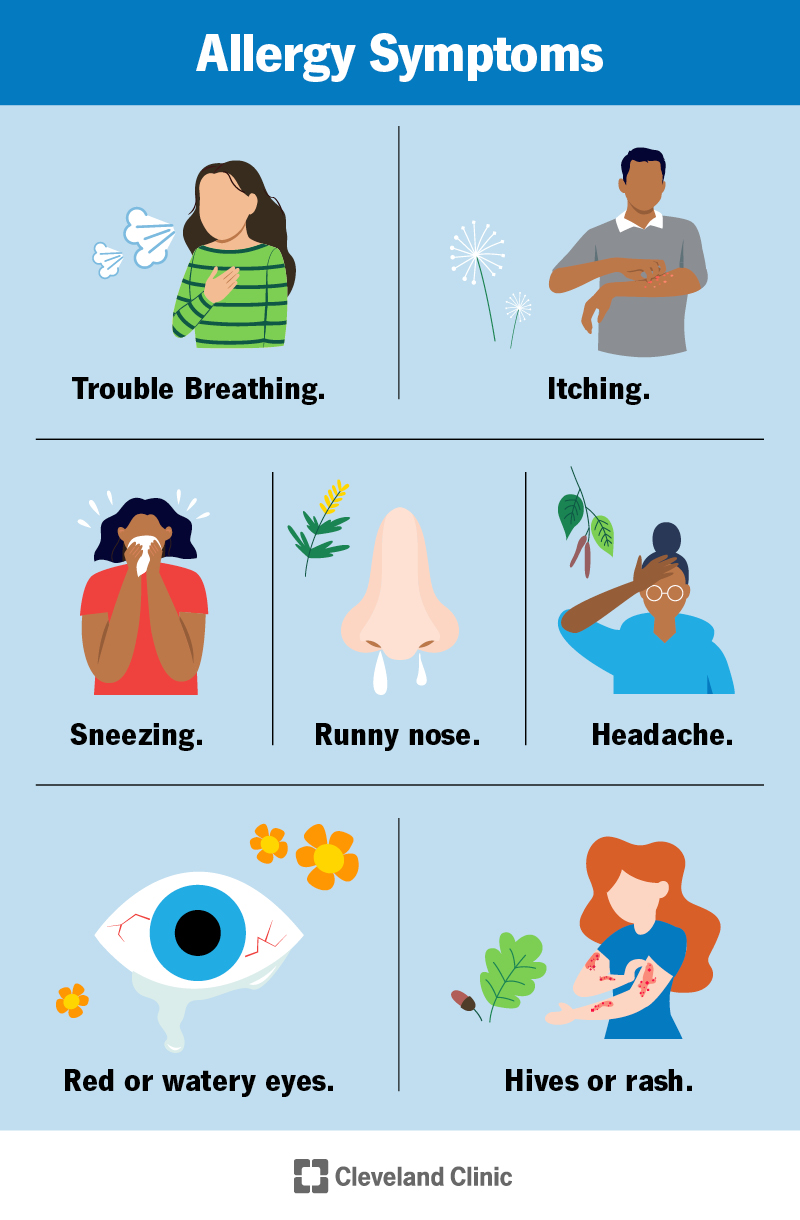Seek immediate medical attention or use an epinephrine auto-injector if you have a severe allergic reaction. For minor reactions, antihistamines may provide relief.
Allergic reactions can vary from mild to life-threatening and recognizing the signs early is essential. They may include symptoms like hives, swelling, itching, respiratory issues, or anaphylaxis—a severe, potentially fatal reaction. Knowing what to do can make all the difference.
Quick access to medication like antihistamines for milder symptoms is crucial. Always carry an epinephrine auto-injector if you're prone to severe reactions. Understanding your triggers and having an action plan prepare you for a timely response, reducing potential complications. Keep emergency contacts handy and inform those around you about your condition, ensuring fast and informed assistance if required. Regular consultations with a healthcare professional can also help manage your allergies effectively.

Credit: my.clevelandclinic.org
Recognizing Allergic Reactions
Allergic reactions can range from mild to life-threatening. It's important to identify the signs early. Understanding these reactions ensures prompt and effective treatment. This section explores different symptoms and types of allergic reactions.
Symptoms To Watch For
Several signs may indicate an allergic reaction. Being aware of them could be life-saving.
- Hives or itchy skin
- Shortness of breath or wheezing
- Swelling of the face, lips, tongue, or other body parts
- Stomach pain, vomiting, or diarrhea
- Rapid heartbeat
- Dizziness or fainting
Types Of Allergic Reactions
Allergic reactions can be immediate or develop over time. They come in various forms.
Type of Reaction |
Common Triggers |
Severity |
|---|---|---|
Anaphylaxis |
Foods, Medication, Insect Stings |
Severe and Life-Threatening |
Contact Dermatitis |
Skin Contact with Allergen |
Mild to Moderate |
Allergic Asthma |
Pollens, Dust Mites, Mold |
Variable |
Urticaria (Hives) |
Food, Medication, Stress |
Mild to Severe |
Identify these allergic reactions and the triggers to manage them effectively. If symptoms appear, seek medical help immediately.

Credit: www.medicalnewstoday.com
Immediate Steps To Take
An allergic reaction can be frightening. Knowing the immediate steps to take can make a significant difference. Act quickly to manage symptoms and prevent a severe reaction. Start with these critical actions.
Stopping Exposure To The Allergen
Identify and remove the allergen right away to stop further reactions. If food causes the issue, stop eating it immediately. For skin contact, wash the area with soap and water. In case of an insect sting, gently remove the stinger. If the reaction is severe, call for emergency help.
Using Over-the-counter Medication
Take antihistamines to alleviate mild symptoms. They can ease itching and swelling. For skin reactions, consider anti-itch creams or lotions. Avoid medication you have not used before or you are allergic to. Always follow the directions on the label. Contact a healthcare professional for advice on medications to keep on hand for unexpected allergic reactions.
Home Remedies For Relief
When an allergic reaction strikes, comfort is key. Home remedies can often provide relief. Natural solutions may reduce symptoms without a trip to the pharmacy. Let's explore options you can use right from the comfort of your home.
Natural Antihistamines
Nature offers its own antihistamines to combat allergies. These are found in foods and herbs. They help your body curb the reaction. Below is a list of natural antihistamines:
- Vitamin C-rich fruits such as oranges and berries
- Quercetin-rich foods like apples and onions
- Herbal teas, particularly nettle leaf or green tea
- Bromelain, found in pineapple, known for its anti-inflammatory properties
Soothing Skin Applications
For skin allergies, topical applications can soothe irritation. Consider these gentle remedies:
- Cold Compress: Apply a damp, chilled cloth to the affected area.
- Aloe Vera Gel: Its properties calm and heal skin inflammation.
- Oatmeal Bath: Grind plain oatmeal and mix in a lukewarm bath.
- Coconut Oil: It moisturizes dry skin and reduces itchiness.
Always do a patch test for new applications to ensure no further reactions occur.

Credit: my.clevelandclinic.org
When To Use An EpiPen
Knowing when to use an EpiPen can save a life during an allergic emergency.
It provides fast, life-saving medication for severe reactions, known as anaphylaxis.
Let's dive into understanding anaphylaxis and using an EpiPen correctly.
Identifying Anaphylaxis
Anaphylaxis is a severe allergic reaction that happens quickly.
It can cause shock, a sudden drop in blood pressure, or trouble breathing.
- Trouble breathing: Wheezing or gasping.
- Skin reactions: Hives, swelling, or redness.
- Shock signs: Low pulse, dizziness, or fainting.
- Gut symptoms: Vomiting or diarrhea.
Spot these signs? Use an EpiPen.
Proper Use Of Epinephrine Auto-injectors
Epinephrine auto-injectors, like EpiPens, need to be used correctly.
- Remove the cap: Take off the blue safety cap.
- Position the pen: Hold it with a fist, orange tip down.
- Inject: Push the orange tip into the outer thigh.
- Hold: Keep it in place for 3 seconds.
- Get help: Dial emergency services right away.
Always keep the used EpiPen with you until help arrives.
It lets doctors see that epinephrine has been given.
Step |
Action |
Details |
|---|---|---|
1 |
Cap Removal |
Take off the safety cap. |
2 |
Pen Position |
The orange tip points to the thigh. |
3 |
Injection |
Press firmly into the thigh. |
4 |
Timer |
Count to three. |
5 |
Emergency Call |
Call for medical help. |
Allergy Medications Explained
Allergies can strike at any time, whether you are at home or outdoors. Understanding the medicines available can help. Let's dive into allergy medications, their types, and how they can bring relief to your symptoms.
Antihistamines Vs. Corticosteroids
Antihistamines and corticosteroids are different. Each fights allergies in its own way.
| Medication Type | How It Works | Common Use |
|---|---|---|
| Antihistamines | Block histamine, stopping allergy symptoms. | Sneezing, runny nose, itching. |
| Corticosteroids | Reduce inflammation in the body. | Long-term relief, nasal sprays. |
Short-term Vs. Long-term Medications
Different allergies need different treatment lengths. Some need short-term relief. Others require long-term management. Know your options.
- Short-term medications provide quick relief.
- They are not for daily use.
- Long-term medications control allergies over time.
- They are part of a daily routine.
``` This HTML content provides clear, concise information suitable for a WordPress blog post targeting readers who need essential information about allergy medications. It's crafted with SEO-friendly language, short sentences, and an easy-to-understand format, making the complex topic accessible to a young audience. The use of tables, bullet points, and bold text helps to emphasize key points, enhancing readability and user experience on the web page.
Seeking Professional Medical Help
Immediate medical assistance can make a crucial difference during an allergic reaction.
Distinguishing Mild From Severe Reactions
Recognizing the severity of an allergic reaction is vital.
- Mild reactions might include itchiness or a minor rash.
- Severe reactions, known as anaphylaxis, can be life-threatening.
- Symptoms like difficulty breathing, dizziness, or swelling call for emergency care.
Locating Urgent Care Or Emergency Services
Here are steps to find urgent care facilities:
- Use a smartphone or GPS to search for nearby locations.
- Prepare a list of local services ahead of any incident.
- For severe cases, call emergency services immediately.
Seeking the right medical help promptly can save lives during allergic reactions.
Preventing Future Allergic Reactions
An unexpected allergic reaction can be a frightening experience. Once you've dealt with the immediate emergency, it's crucial to focus on how to prevent future incidents. By understanding your allergies and making some lifestyle adjustments, you can drastically reduce the likelihood of repeated reactions. Explore options like allergy testing and immunotherapy, and adopt lifestyle changes with avoidance strategies.
Allergy Testing And Immunotherapy
Finding the cause of your allergies is the first step to prevention. Allergy testing helps identify specific allergens. Once you know what to avoid, it's easier to prevent reactions. Immunotherapy, such as allergy shots, can decrease your sensitivity to allergens over time.
- Skin prick tests: Identifies allergens quickly.
- Blood tests: Detects antibodies against allergens.
- Allergy shots: Builds tolerance gradually.
Lifestyle Adaptations And Avoidance Strategies
Changing daily habits can minimize exposure to allergens. Simple strategies include:
Allergen |
Avoidance Strategy |
|---|---|
Dust mites |
Use allergen-proof bed covers. |
Pollen |
Keep windows closed during the high pollen season. |
Food |
Read labels; avoid cross-contamination. |
Additionally, wear medical alert jewelry and carry an epinephrine auto-injector. Create an allergy action plan and share it with family and friends. Being prepared can save your life.
Conclusion
Dealing with allergic reactions can be daunting, yet being prepared makes a significant difference. Remember to identify triggers, have medications on hand, and seek medical assistance when necessary. Keep educating yourself on allergy management—your health and peace of mind depend on it.
Stay safe and proactive for a worry-free lifestyle.


